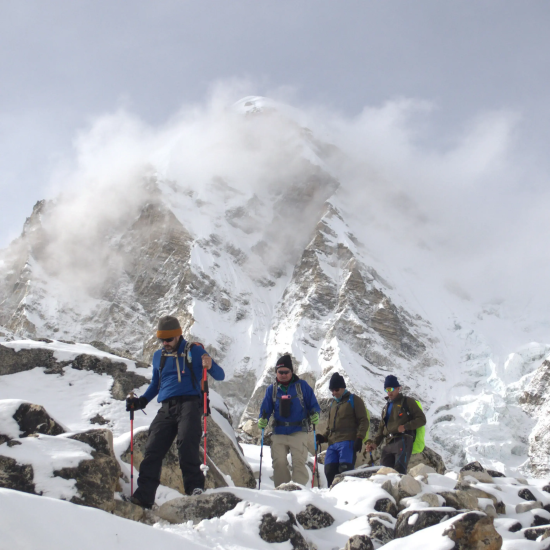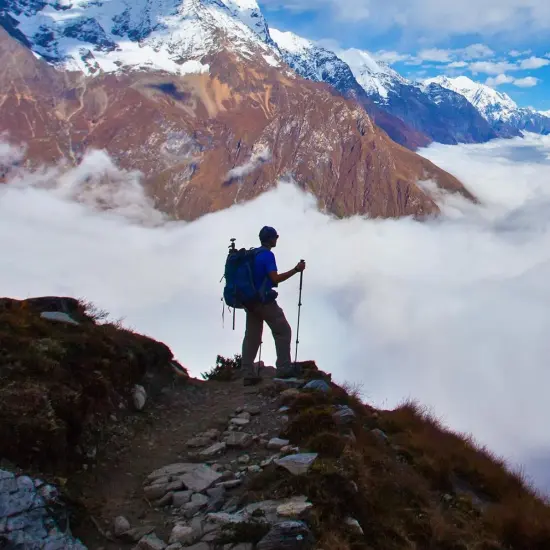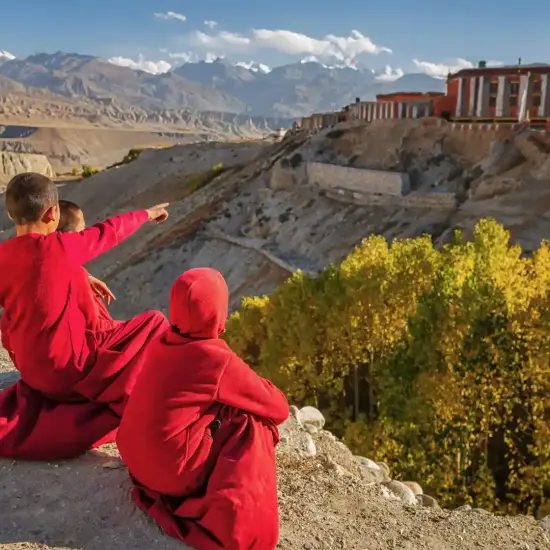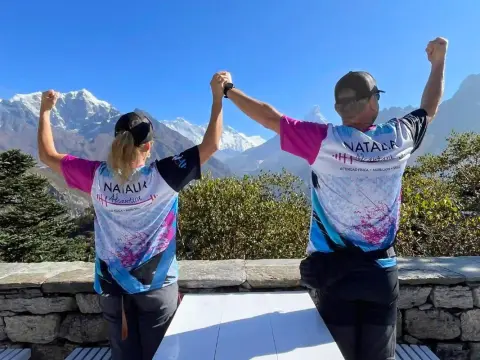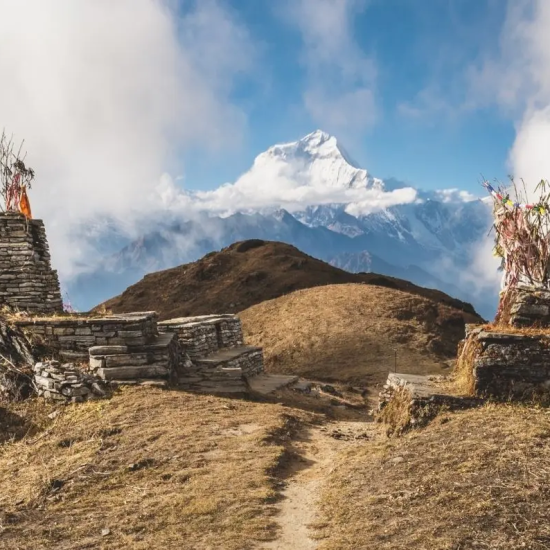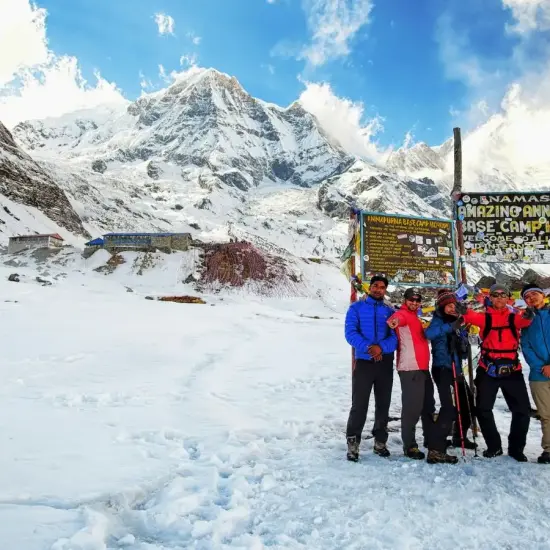The 7-day Tilicho Lake Trek is a stunning high-altitude journey through the heart of Nepal’s Annapurna region. Reaching Tilicho Lake at 4,919 meters—one of the world’s highest lakes—this trek blends mountain adventure with cultural immersion in Himalayan villages. Starting from Kathmandu, the route winds through pine forests, alpine landscapes, and arid highlands, passing through traditional settlements like Chame, Upper Pisang, and Manang. Along the way, trekkers are rewarded with breathtaking views of the Annapurna Massif, Gangapurna, Tilicho Peak, and Chulu ranges. Designed for those with limited time but a strong spirit of adventure, this one-week itinerary offers a fulfilling trekking experience.
The trek begins with a long but scenic drive from Kathmandu (1,400 m) to Chame (2,650 m), the gateway to the Annapurna region. En route, trekkers enjoy views of lush hills and soaring peaks like Manaslu (8,163 m), Lamjung Himal (6,983 m), and Annapurna II (7,937 m). From Chame, the trail heads to Upper Pisang (3,300 m), revealing dramatic Himalayan panoramas and the iconic curved rock face of Paungda Danda. Day three leads to Manang (3,519 m), a cultural hub framed by towering peaks such as Gangapurna (7,455 m), Tilicho Peak (7,134 m), and Chulu West (6,419 m). This village offers opportunities for acclimatization hikes to Ice Lake, Gangapurna Lake, and Praken Gompa.
From Manang, the path ascends to Tilicho Base Camp (4,150 m) via the remote villages of Khangsar and Shree Kharka. This section includes narrow, landslide-prone trails with awe-inspiring vistas. After an overnight rest, trekkers rise early for the final push to Tilicho Lake (4,919 m), surrounded by the majestic Nilgiri, Tilicho Peak, and the icy wall of the Grand Barrier. The descent continues to Shree Kharka (4,050 m), before heading back to Manang and concluding with a drive to Kathmandu. The journey delivers both physical challenge and spiritual reward, set amidst some of the most remarkable mountain scenery in the Himalayas.
Along the route, trekkers pass monasteries, prayer flags, yak pastures, and glacial rivers—each moment enriching the cultural and natural experience. The hospitality of the local people and the simplicity of mountain life add to the trek’s charm. Despite the short timeframe, each day covers diverse terrain and scenery. Accommodations are in traditional tea houses offering basic but comfortable lodging and meals. The best seasons for this trek are spring (March–May) and autumn (September–November), when the skies are clear, temperatures are stable, and the mountain views are at their finest.
To undertake the Tilicho Lake Trek, trekkers must obtain two permits: the Annapurna Conservation Area Permit (ACAP) and the Trekkers’ Information Management System (TIMS) card. For SAARC nationals, the ACAP costs NPR 1,000 and TIMS NPR 300. For other international trekkers, the ACAP is NPR 3,000 and TIMS NPR 2,000. These can be secured in Kathmandu or Pokhara through the Nepal Tourism Board or licensed trekking agencies. Ensure you carry passport-sized photos and a valid ID. Proper acclimatization, a reasonable level of fitness, and adequate trekking gear are essential for completing this rewarding high-altitude trek safely.
Whether you dream of standing beneath the world’s highest peaks or walking along ancient Sherpa trade routes, the Tilicho Lake Trek offers challenge and reward like no other. Join us at Places Nepal Pvt. Ltd. and let your Himalayan story begin. Contact us today to customize your itinerary, check group departures, or ask any questions—our team is here to help every step of the way!
Trek Attractions and Highlights:
- Tilicho Lake (4,919 m): One of the highest lakes in the world, surrounded by towering snow-capped peaks.
- Annapurna II, III, IV, Gangapurna, Tilicho Peak, Nilgiri, Chulu Peaks: Stunning views throughout the trek.
- Traditional villages: Chame, Upper Pisang, Manang, and Shree Kharka offer insight into local life.
- Buddhist culture: Monasteries, prayer wheels, and chortens along the trail.
- Varied landscapes: From pine forests and waterfalls to alpine meadows and glacial basins.
Route Description & Altitude Highlights:
- Day 1: Kathmandu (1,400 m) to Chame (2,650 m) – 8–9 hrs drive
- Day 2: Trek to Upper Pisang (3,300 m) – 5–6 hrs
- Day 3: Trek to Manang (3,519 m) – 6–7 hrs
- Day 4: Acclimatization in Manang (Optional hike to Ice Lake or Praken Gompa)
- Day 5: Trek to Tilicho Base Camp (4,150 m) – 6–7 hrs
- Day 6: Hike to Tilicho Lake (4,919 m) and descend to Shree Kharka (4,050 m) – 7–8 hrs
- Day 7: Return to Manang and drive back to Kathmandu – Full day










































